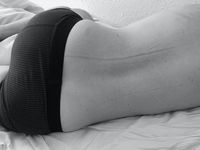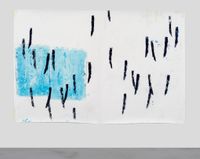Esther Kläs is a contemporary artist best known for her monolithic sculptures most frequently made from concrete and resin. She also works in painting and printmaking, often placing all three media in dialogue with each other in her installations. Moving fluidly between two- and three-dimensional methodologies, Kläs explores marks and forms as records of the moment of their creation.
Read MoreThough stoic from a distance, Kläs' work is delicate in detail. She tends to use materials she can manipulate by hand, and frequently leaves traces of the construction process behind. In this way, Kläs' work lends itself to the history of action painting, in which the final art object acts as documentation of a physical gesture. At a distance, the sculpture la nuit (2012) seems like a plain slab of concrete, but on closer inspection it possesses stripe-like indentations; the texture looks as if Kläs gently ran her fingers through the drying cement. This intentional irregularity lends the sculpture a feeling of temporality despite its scale and solid presence in the room.
Kläs' practice may be best observed historically as a descendant of Eva Hesse's post-Minimalist fascination with the bodily nature of materials. Kläs' monumental sculptures tend to rest around human-height, granting them anthropomorphic qualities. The other day (2016) is a tall slab of Hydrocal (a gypsum cement) in a burgundy hue. The slab has two metal poles sticking down from its bottom side, elevating it off the floor in the same way that legs lift a body off the ground. The sculpture begins to hover between an abstract exploration of form, materiality and weight, and an imaginative narrative in which a cement slab vibrates with life.
Kläs installs her sculptures to work in deliberate conversation with each other throughout each exhibition space they inhabit. In HERE (2014), an iron hoop is suspended from the ceiling on four sets of rope while, a couple of metres away, a piece of rubber tubing mirrors a section of the curve. The two parts of the one piece speak to each other across the room, but the distance between each half allows the viewer to interrupt—or perhaps become a part of—their conversation; the artist successfully manipulates not only the relationship between the sculptures, but also the relationship between the sculptures and the viewer moving through the room.
Kläs first attended Kunstakademie Düsseldorf in Germany, and then earned her MFA from Hunter College in New York. She lives and works in Barcelona.
Casey Carsel | Ocula | 2018





